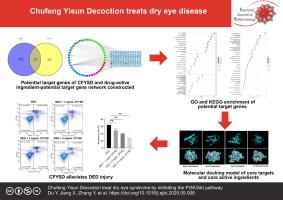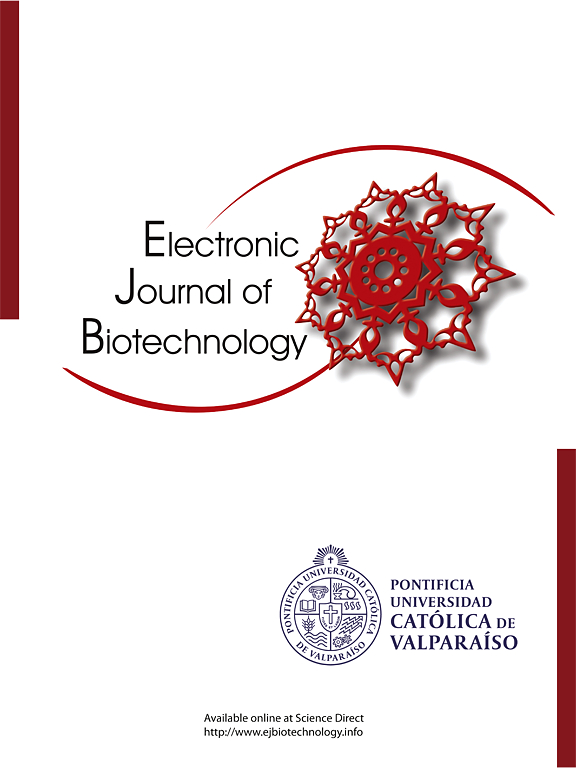出风益孙汤通过抑制PI3K/Akt通路治疗干眼症
IF 2.5
4区 生物学
Q3 BIOTECHNOLOGY & APPLIED MICROBIOLOGY
引用次数: 0
摘要
干眼病严重影响人们的工作和生活。出风益孙汤是一种治疗干眼症的中药汤剂。本研究旨在探讨CFYSD在干眼病中的核心活性成分、靶点及作用机制,为干眼病的治疗提供新的见解。结果从出风益孙汤中共筛选出196个靶基因,其中干眼症相关基因170个。基因本体和KEGG富集分析显示,初风益孙汤通过“脂质与动脉粥样硬化”、“流体剪应力与动脉粥样硬化”、“PI3K-Akt”影响干眼症。出风益孙汤治疗干眼症的核心靶点是Akt1和IL-1β。主要活性成分为山奈酚、枸杞素和槲皮素。分子对接结果表明,山奈酚与Akt1、枸杞素与Akt1、槲皮素与Akt1、槲皮素与IL-1β的结合能分别为−6.1、−6.1、−6.1和−7.9 kcal/mol。出风益孙汤明显减轻细胞损伤,降低PI3K/Akt通路相关蛋白表达。PI3K的激活部分逆转了出风益孙汤对干眼症的治疗作用。结论舒风益孙汤通过多成分、多靶点灭活PI3K/Akt通路治疗干眼症。引用方式:杜勇,姜旭,张勇,等。出风益孙汤通过抑制PI3K/Akt通路治疗干眼症。中国生物医学工程学报(英文版);2009;38。https://doi.org/10.1016/j.ejbt.2025.05.006。本文章由计算机程序翻译,如有差异,请以英文原文为准。

Chufeng Yisun Decoction treats dry eye syndrome by inhibiting the PI3K/Akt pathway
Background
Dry eye disease seriously affects people’s work and life. Chufeng Yisun Decoction is a traditional Chinese medicine decoction used in treating dry eye disease. This study aims to explore the core active ingredients, targets, and mechanisms of CFYSD in dry eye disease, providing new insights for the dry eye disease treatment.
Results
A total of 196 target genes were screened from Chufeng Yisun Decoction, and 170 genes were related to dry eye disease. Gene Ontology and KEGG enrichment analyses showed that Chufeng Yisun Decoction influenced dry eye disease through “Lipid and atherosclerosis”, “Fluid shear stress and atherosclerosis”, and “PI3K-Akt”. The core targets of Chufeng Yisun Decoction in treating dry eye disease were Akt1 and IL-1β. The core active ingredients were kaempferol, wogonin, and quercetin. Molecular docking results showed that the binding energies of kaempferol and Akt1, wogonin and Akt1, quercetin and Akt1, and quercetin and IL-1β were −6.1, −6.1, −6.1, and −7.9 kcal/mol, respectively. Chufeng Yisun Decoction significantly alleviated cell damage and reduced PI3K/Akt pathway-related protein expression. PI3K activation partially reversed the therapeutic effect of Chufeng Yisun Decoction on dry eye disease.
Conclusions
Chufeng Yisun Decoction treats dry eye disease by inactivating the PI3K/Akt pathway through multi-ingredients and multi-targets.
How to cite: Du Y, Jiang X, Zhang Y, et al. Chufeng Yisun Decoction treat dry eye syndrome by inhibiting the PI3K/Akt pathway. Electron J Biotechnol 2025;78. https://doi.org/10.1016/j.ejbt.2025.05.006.
求助全文
通过发布文献求助,成功后即可免费获取论文全文。
去求助
来源期刊

Electronic Journal of Biotechnology
工程技术-生物工程与应用微生物
CiteScore
5.60
自引率
0.00%
发文量
50
审稿时长
2 months
期刊介绍:
Electronic Journal of Biotechnology is an international scientific electronic journal, which publishes papers from all areas related to Biotechnology. It covers from molecular biology and the chemistry of biological processes to aquatic and earth environmental aspects, computational applications, policy and ethical issues directly related to Biotechnology.
The journal provides an effective way to publish research and review articles and short communications, video material, animation sequences and 3D are also accepted to support and enhance articles. The articles will be examined by a scientific committee and anonymous evaluators and published every two months in HTML and PDF formats (January 15th , March 15th, May 15th, July 15th, September 15th, November 15th).
The following areas are covered in the Journal:
• Animal Biotechnology
• Biofilms
• Bioinformatics
• Biomedicine
• Biopolicies of International Cooperation
• Biosafety
• Biotechnology Industry
• Biotechnology of Human Disorders
• Chemical Engineering
• Environmental Biotechnology
• Food Biotechnology
• Marine Biotechnology
• Microbial Biotechnology
• Molecular Biology and Genetics
•Nanobiotechnology
• Omics
• Plant Biotechnology
• Process Biotechnology
• Process Chemistry and Technology
• Tissue Engineering
 求助内容:
求助内容: 应助结果提醒方式:
应助结果提醒方式:


